
The Yuma Territorial Prison is a former prison located in Yuma, Arizona, United States. Opened on July 1, 1876, and shut down on September 15, 1909. It is one of the Yuma Crossing and Associated Sites on the National Register of Historic Places in the Yuma Crossing National Heritage Area. The site is now operated as a historical museum by Arizona State Parks as Yuma Territorial Prison State Historic Park.

This is a directory of properties and districts listed on the National Register of Historic Places in Arizona. There are about fourteen hundred listed sites in the state, and each of its fifteen counties has at least ten listings on the National Register. Forty-seven of the state's sites are further designated as National Historic Landmarks.

Fort Yuma was a fort in California located in Imperial County, across the Colorado River from Yuma, Arizona. It was Established in 1848. It served as a stop on the Butterfield Overland Mail route from 1858 until 1861. The fort was retired from active military service on May 16, 1883, and transferred to the Department of the Interior. The Fort Yuma Indian School and the Saint Thomas Yuma Indian Mission now occupy the site. It is one of the "associated sites" listed as Yuma Crossing and Associated Sites on the National Register of Historic Places in the Yuma Crossing National Heritage Area. In addition, it is registered as California Historical Landmark #806.

Yuma Crossing is a site in Arizona and California that is significant for its association with transportation and communication across the Colorado River. It connected New Spain and Las Californias in the Spanish Colonial period in and also during the Western expansion of the United States. Features of the Arizona side include the Yuma Quartermaster Depot and Yuma Territorial Prison. Features on the California Side include Fort Yuma, which protected the area from 1850 to 1885.
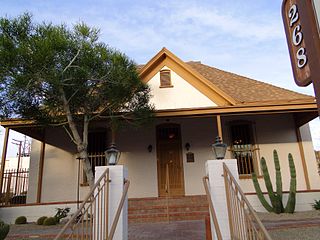
The Brown House is a 19th-century house in Yuma, Arizona, built of brick in the 1890s.

Yuma Quartermaster Depot State Historic Park, formerly Yuma Crossing State Historic Park, and now one of the Yuma Crossing and Associated Sites on the National Register of Historic Places in the Yuma Crossing National Heritage Area. It is an Arizona state park in the city of Yuma, Arizona, US.

This is a list of the National Register of Historic Places listings in Yuma County, Arizona. It is intended to be a complete list of the properties and districts on the National Register of Historic Places in Yuma County, Arizona, United States. The locations of National Register properties and districts for which the latitude and longitude coordinates are included below, may be seen in a map.
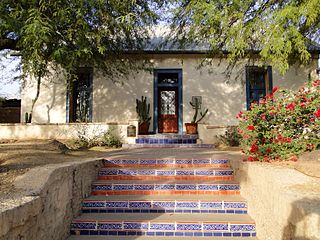
Ortiz House in Yuma, Arizona was built in 1901. It was listed on the National Register of Historic Places in 1982.
The Southern Pacific Railroad Depot in Yuma, Arizona, was built as a Spanish Colonial Revival-style station by the Southern Pacific Railroad in 1926.
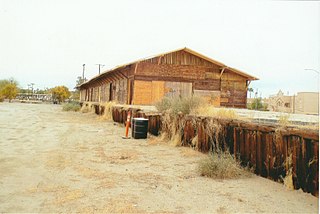
Southern Pacific Freight Depot in Yuma, Arizona was built in 1891, built with redwood shiplap and in the wooden Stick—Eastlake architectural motifs of the Victorian Queen Anne Style.
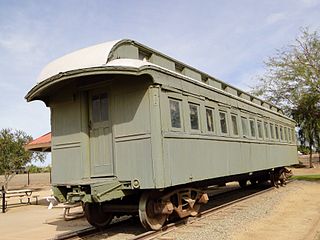
Southern Pacific Railroad Passenger Coach Car-S.P. X7 dates from c. 1875 and was used until 1938. It is a former passenger coach of the Southern Pacific Railroad's Southern Division. The railway vehicle was listed on the National Register of Historic Places in 2000, at which time it was located in Yuma, Arizona.

The Masonic Temple in Yuma, Arizona, was built in 1931 in the late Art Deco style of Moderne. It was designed by Los Angeles–based architects Edward Gray Taylor and Ellis Wing Taylor. In 1933, at the depth of the Great Depression, the Masonic lodge lost all its funds in a bank closure. On November 16, 1933, the building's ownership was turned over to the Pacific Mutual Life Insurance Company "in satisfaction of a $16,900 realty mortgage." It was later rented back to the Masonic chapter and on May 10, 1940, ownership was restored.
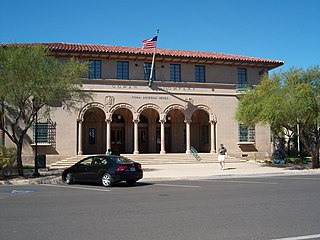
The Gowan Company Building, formerly known as the Yuma Main Post Office or Yuma Downtown Postal Annex, is a historic building in Yuma, Arizona. Constructed in 1933 to serve as the city's main post office, the building's design, a work of architect Roy Place, is a blend of the Beaux Arts and Spanish Colonial Revival styles. The design includes a loggia supported by Corinthian columns, wrought iron railings and window bars, a molded belt course between the building's two stories, a projecting bracketed cornice, and a red tile roof. The post office was built toward the end of the Beaux-Arts phase of federal building design, as government architects shifted to a "starved classicism" style in the ensuing years.

The Brinley Avenue Historic District is a historic district in downtown Yuma, Arizona, that runs along Madison Avenue from 1st to 3rd Streets and along Second Street from Main Street to 1st Avenue. The district connected Yuma's historic commercial center along Main Street with its government center on 2nd Avenue and was actively developed from 1900 to 1925. The district was added to the National Register of Historic Places in 1982 and is also included in the larger Yuma Crossing National Heritage Area.

The Ocean-to-Ocean Bridge is a through truss bridge spanning the Colorado River in Yuma, Arizona. Built in 1915, it was the first highway crossing of the lower Colorado and is the earliest example of a through truss bridge in Arizona. It is also the only example of a Pennsylvania truss within Arizona. Originally the bridge carried the transcontinental Ocean-to-Ocean Highway and later carried its successor, US 80 until a new bridge was built to the west in 1956. Between 1988 and 2001, the bridge was closed to vehicular traffic and only traversable by pedestrians and bicyclists. After a major restoration, the bridge was rehabilitated and reopened to vehicular traffic in 2002, with a re-dedication by the Quechan nation and Yuma Crossing National Heritage Area. The bridge became part of Historic US 80 in 2018.
The Mexican Consulate is a historic adobe house in Yuma, Arizona. It was built circa 1892 for Dionicio Sanchez and his wife, Mary. In 1897, it was purchased by John Stoffela, who rented it to Henry M. Gandolfo, the Mexican consul, in the 1900s. The house housed the Mexican consulate in Yuma while Gandolfo resided there. It remained in the Stoffela family until 1978. It has been listed on the National Register of Historic Places since December 7, 1982.
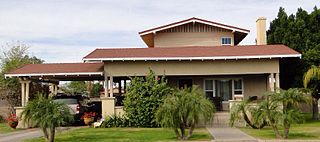
The J. Homer Smith is a historic house in Yuma, Arizona. It was built in 1917 for J. Homer Smith, a druggist and banker who served as the mayor of Yuma. He later moved to Tucson, and he died in 1936. The house was designed in the American Craftsman architectural style. It has been listed on the National Register of Historic Places since December 7, 1982.

The Caruthers House is a historic house in Yuma, Arizona. It was built in 1895 for F. B. Logan and was extensively remodeled in 1906. It was purchased by C. E. Eichelberger in 1900, and by E. G. Caruthers in 1906. The latter was a banker. The house was designed in the American Craftsman architectural style. It has been listed on the National Register of Historic Places since December 7, 1982.

















